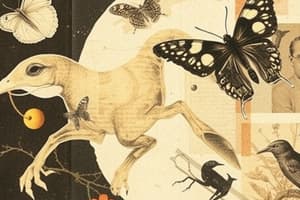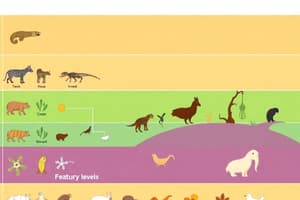Podcast
Questions and Answers
What must occur for a trait variant selected against to persist in future generations?
What must occur for a trait variant selected against to persist in future generations?
- It must be a dominant trait.
- It must be favored by artificial selection.
- It must be present in every individual of the population.
- It must be genetically manifested and offer a selective advantage. (correct)
What type of cells do prokaryotes have?
What type of cells do prokaryotes have?
- Cells with complex organelles
- Cells with a nucleus
- Cells that are multicellular
- Cells without a nucleus (correct)
What leads to genetic variation within a population?
What leads to genetic variation within a population?
- Individual genetic differences (correct)
- Uniform allele distribution
- Similar environmental conditions
- A single genotype across the population
Which kingdom within the Domain Eukarya consists of multicellular, autotrophic organisms?
Which kingdom within the Domain Eukarya consists of multicellular, autotrophic organisms?
What are the alleles of the ABO blood type gene?
What are the alleles of the ABO blood type gene?
Which of the following represents a combination of alleles for blood type O?
Which of the following represents a combination of alleles for blood type O?
What is a characteristic of the kingdom Fungi?
What is a characteristic of the kingdom Fungi?
Within the Kingdom Animalia, how many phyla approximately exist?
Within the Kingdom Animalia, how many phyla approximately exist?
What is the effect of codominance in the ABO blood type?
What is the effect of codominance in the ABO blood type?
Which domain does Archaea belong to?
Which domain does Archaea belong to?
Why might there be more blonde-haired individuals in Northern Europe than in the Mediterranean?
Why might there be more blonde-haired individuals in Northern Europe than in the Mediterranean?
What distinguishes eukaryotic cells from prokaryotic cells?
What distinguishes eukaryotic cells from prokaryotic cells?
What contributes to the formation of a trait?
What contributes to the formation of a trait?
What does genetic variation between populations lead to in a species?
What does genetic variation between populations lead to in a species?
Which of the following kingdoms is unicellular or multicellular but consists primarily of unicellular organisms?
Which of the following kingdoms is unicellular or multicellular but consists primarily of unicellular organisms?
In the biological classification system, what follows 'Phylum'?
In the biological classification system, what follows 'Phylum'?
What is a scientific hypothesis?
What is a scientific hypothesis?
Which of the following best describes a scientific theory?
Which of the following best describes a scientific theory?
Which scientist is known for their work in genetics and is often referred to as the father of modern genetics?
Which scientist is known for their work in genetics and is often referred to as the father of modern genetics?
What is true about a scientific model?
What is true about a scientific model?
What term refers to the science concerned with life and living organisms?
What term refers to the science concerned with life and living organisms?
What requirement must a scientific experiment meet to effectively test a hypothesis?
What requirement must a scientific experiment meet to effectively test a hypothesis?
Which of the following scientists contributed significantly to the study of microorganisms?
Which of the following scientists contributed significantly to the study of microorganisms?
What does the phrase 'the predicted outcome may differ from the observed outcome' imply about scientific models?
What does the phrase 'the predicted outcome may differ from the observed outcome' imply about scientific models?
What is the primary goal of science as stated in the content?
What is the primary goal of science as stated in the content?
Which approach involves reasoning from specific observations to a general conclusion?
Which approach involves reasoning from specific observations to a general conclusion?
What advances in science have led to significant progress in biology since the late 20th century?
What advances in science have led to significant progress in biology since the late 20th century?
Which of the following is NOT typically associated with the natural sciences?
Which of the following is NOT typically associated with the natural sciences?
Who of the following scientists was influential during the early 19th century in exploring the natural world and its systems?
Who of the following scientists was influential during the early 19th century in exploring the natural world and its systems?
What does the term homology refer to in evolutionary biology?
What does the term homology refer to in evolutionary biology?
What does the phrase 'Ontogeny Repeats Phylogeny' imply about embryonic development?
What does the phrase 'Ontogeny Repeats Phylogeny' imply about embryonic development?
What is the key characteristic of analogous structures?
What is the key characteristic of analogous structures?
What is suggested by the statement that both homologies and analogies result from natural selection?
What is suggested by the statement that both homologies and analogies result from natural selection?
In the biological classification system, which category follows 'Phylum'?
In the biological classification system, which category follows 'Phylum'?
What is the definition of a species in biological terms?
What is the definition of a species in biological terms?
Which of the following best describes the term 'phylogenetic relationships'?
Which of the following best describes the term 'phylogenetic relationships'?
How do similar performance characteristics in organisms of different origins relate to evolutionary biology?
How do similar performance characteristics in organisms of different origins relate to evolutionary biology?
Study Notes
Categorizing Life
- Three domains: Archaea (prokaryotes), Bacteria (prokaryotes), and Eukarya (eukaryotes).
- Prokaryotic cells lack a nucleus; DNA is free in the cytoplasm.
- Eukaryotic cells possess a nucleus containing DNA.
Eukarya's Kingdoms
- Four kingdoms within the Eukarya domain: Protista (unicellular, some multicellular algae), Animalia (multicellular, no cell walls, heterotrophs), Plantae (multicellular, cell walls, autotrophs), and Fungi (multicellular, cell walls, heterotrophs).
Taxonomic Hierarchy within Animalia
- Kingdom Animalia is divided into approximately 33 phyla.
- Each phylum contains several classes (about 107 total).
- Classes are further divided into orders, families, genera, and finally, species.
Trait Variation and Inheritance
- For a trait variant to be selected against, it must be heritable (genetically manifested) and offer a selective advantage.
Evolution of Behavior: Natural vs. Artificial Selection
- Trait variety stems from genetic variation.
- Genes exist in different variants called alleles (e.g., hair color gene with black, brown, and blonde alleles).
- Traits are usually influenced by multiple genes.
- Individual genetic differences create genetic variation within populations.
- Genetic differences between populations lead to genetic variation within a species.
Human ABO Blood Type Example
- Three alleles for the ABO gene: Type A, Type B, and Type O.
- Individuals inherit one allele from each parent.
- Type A and B are codominant; O is recessive.
Key Figures in Biology's History
- Alexander von Humboldt (1769-1859)
- Charles Darwin (1809-1882)
- Gregor Mendel (1822-1884)
- Louis Pasteur (1822-1895)
- Jean-Henri Fabre (1823-1915)
Biology: A Science of Life
- Modern biology experienced significant growth in the 19th and late 20th centuries.
- Advancements driven by new tools, methods, and technologies, including computer technology, molecular biological methods, genome databases, and imaging techniques.
What is Science?
- Natural sciences are largely descriptive and empirical, based on evidence gathering through observation, description, and interpretation.
- The goal of science is to understand and explain the world.
- Scientific approaches include deductive and inductive reasoning.
Scientific Hypothesis, Theory, and Model
- A scientific hypothesis is a tentative, testable explanation for an observed phenomenon.
- A scientific theory explains an observed phenomenon based on a series of verified hypotheses.
- A scientific model is a tool used to understand and predict observations based on experimental results.
- Scientific models are not representations of reality but tools to understand and explain observed phenomena
The Golgi/Cajal Dispute
- Illustrates how science progresses through debate and refinement of understanding.
- The dispute between reticularists and neuronists led to the birth of modern neuroscience.
Homology vs. Analogy
- Homology: Different forms sharing a common origin/ancestor. Embryonic development offers clues to phylogenetic relationships ("ontogeny repeats phylogeny").
- Analogy: Similar structures and functions, but different origins, arising from convergent evolution. Form follows function. Both are consequences of natural selection.
Roadmap to the Tree of Life
- Illustrates taxonomic classification: Kingdom, Phylum, Class, Order, Family, Genus, Species.
- Example: Panthera leo (lion) within the Animalia kingdom.
Defining a Species
- A complex question with no simple answer.
Studying That Suits You
Use AI to generate personalized quizzes and flashcards to suit your learning preferences.
Related Documents
Description
Explore the classifications and characteristics of life forms in this quiz covering three domains: Archaea, Bacteria, and Eukarya. Delve into the kingdoms of Eukarya and the taxonomic hierarchy within Animalia, along with concepts of trait variation and natural selection. Understand how evolutionary mechanisms shape behavioral traits.




